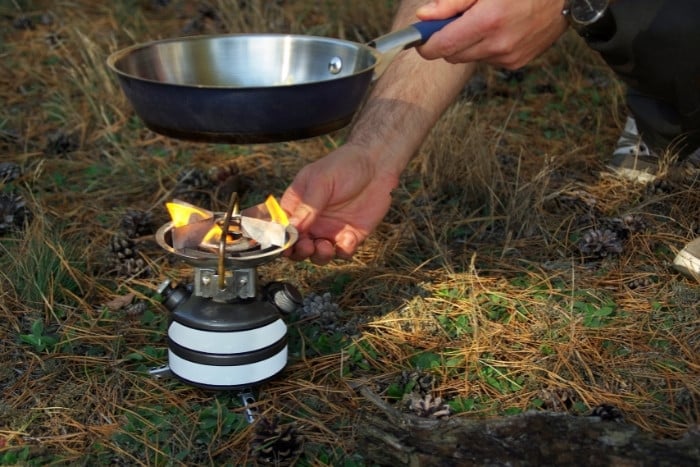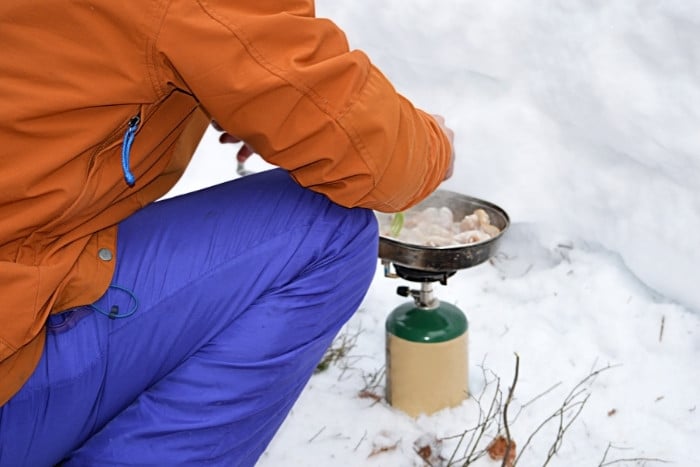Perhaps you’ve bought a camping stove before, or maybe you’re in the market for your first. It can be daunting to purchase a canister stove but don’t worry, we have everything you need to know in this article.
Canister stoves are compact and lightweight, making them easy to use. They provide a steady flame, which is ideal for cooking meals or boiling water. However, canister stoves come with challenges, such as inefficient use in the cold. They can be more expensive than other types of camping stoves.
We’ve given you eight advantages and eight disadvantages of a canister stove. Hopefully, it’ll provide you with everything you need to know to make your camping stove dreams come true.
Pros of Using a Canister Stove
We explore how these ultralight canister stoves are simple to use, very compact, and efficient. This stove will benefit your camping trip and provide quick, hot food.
Here are some more reasons a canister stove is what you need.
1. Simple to use
This stove is extremely easy to use. It consists of two components, the stove, and the fuel canister. The canisters themselves are simple to replace as well.
All you need to do is screw them to each other, switch on the fuel valve, light it, and you’re ready to go.

2. Solid longevity
These stoves can run reliably for decades. The construction is simple, so they require very little maintenance.
If you experience any issues or feel your stove may need a service, it is always recommended to take it to a professional.
It’s good practice to keep your stoves cleaned and well maintained as this will increase the durability.
3. Compact size
The canister stove is compact, making it great for backpacking or solo trips. It’s also great if you prefer lighter equipment.
The best bit about a canister stove is that it usually fits in one of my cooking pots, so I’m not compromising space for two pieces of equipment.
4. Lightweight
This stove is very lightweight, making it the perfect choice for backpacking. These ultralight stoves make hot meals more manageable on shorter camping trips.
Compared to other stoves, such as liquid fuel bottles, canister stoves are the king of lightweights.
5. Built-in pressure regulator
Some canister stoves have a built-in pressure regulator. The regulator ensures a consistent heat output throughout use, making it more efficient in the cold.
It’s more reliable than stoves that use pellets or wood because you know the heat is dependable.
6. Cooking simple food
Since the stove heats up super quick, it is best to cook simple meals. The canister is perfect if you’re a fan of soups, one-pot lunches, or stews.
Dishes that have multiple cooking components may take longer and won’t be as delicious.
7. Quick to light
Another advantage of the stove canister is that they begin heating instantly as soon as they are lit. This means no waiting for a heating pad to start sizzling or coals to turn gray.
You can even boil a liter of water in less than 5 minutes. The flame is also adjustable, so you can easily simmer or gently warm dishes.
8. Self-Seals
The canister has a self-seal that stops the gas from leaking out and reduces drips. These seals are a smarter, safer way to cook and should be considered with any stove you buy.
There’s also nothing worse than your belongings getting covered in gas!
Cons of Using a Canister Stove
While canister stoves might be the stove that you’re looking for, there are several disadvantages we need to let you know about! These handy stoves might not be as stable as you think.
They can also get pretty pricey. Here are things you might want to consider.
1. Inefficient in the cold
Unfortunately, these stoves can be ineffective in chillier climates. In cold weather, the canister can depressurize, impacting the flame’s effectiveness. In some cases, it can make the flame non-existent.
Some stoves deal with the cold better if you are on set on this canister for a colder expedition.

2. Stability
The canisters are top-heavy, so they can have some serious stability issues, especially if you’re camping somewhere windy.
This is not helped by how lightweight the stove is, making this instability even more obvious. We highly recommend camping away from the wind unless you want your dinner all over the side of a mountain.
3. How much is left?
One of my greatest camping peeves is not being able to tell how much fuel is left in my canister and asking if it is enough to make a cup of tea. The canister stove has this exact problem.
If you are using a canister stove, you must keep tabs on how much you’ve used. Meanwhile, liquid fuel bottles show you exactly how much fuel you have left, so this is never an issue.
4. Canisters are not reusable
Sadly, the canisters are not reusable and must be disposed of properly. This could be irritating if your backpack is full of empty canisters while searching for a place to dispose of them!
Luckily, while this may feel like a long-winded task, the canisters themselves are recyclable! Just remember to have the empty canister punctured before throwing in the recycling.
Never throw away a full canister.
5. Short stove arms
Most canister stoves have set arms, so you can’t extend them to fit bigger pots or pans. This can be irritating if your stove has multiple uses or is used for bigger parties.
However, it is possible to purchase component add-ons to sit on your stove to make it bigger.
6. Where’s the canister?
The canisters used for the stove can be purchased at most outdoor stores. However, it could be difficult to source one if you’re off the beaten track.
If you are likely to be hiking in the middle of nowhere for a long time, it would be helpful to either stock up or choose a stove that uses natural resources.
7. Fuel canisters are expensive
Unlike liquid fuel bottles or wood, isobutene fuel canisters are expensive.
If you’re planning to use a canister stove for long trips, remember how many fuel canisters you’ll need and how much this could set you back. At least the initial cost of a canister stove is usually cheap.
8. Do not use a windscreen
Lastly, canister stoves mustn’t be used inside a windscreen. The windscreen can isolate the heat from the stove and lead to a fuel explosion. To avoid this hazard, ventilation is key!
Conclusion
There are several advantages and disadvantages that you need to consider before purchasing a canister stove. They are compact, lightweight, require little maintenance, and are simple to set up.
However, their stability is questionable (especially if you’re somewhere windy!), and they are useless in cold climates. If asked if we recommend purchasing a canister stove? The answer is yes.
This is great gear to get you hot food quickly, and we believe it’s worth it!
